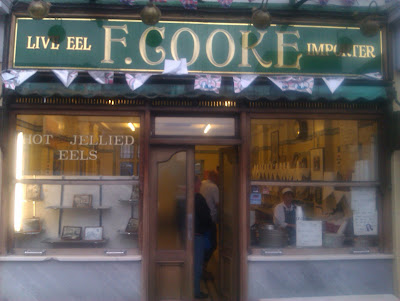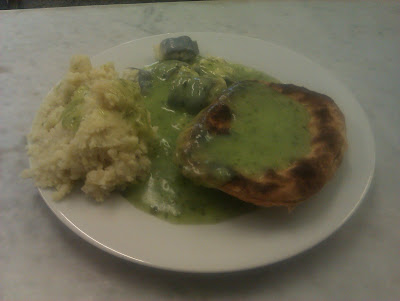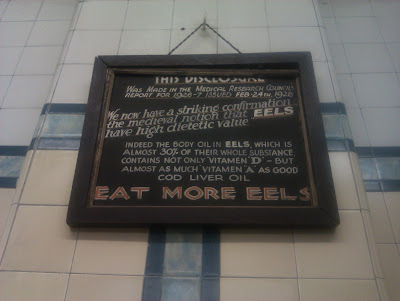
Restaurant: G Cooke's
Location: Hackney
By Boeing: 2180 miles
By Boris Bike: 3.5 miles
Having gone too far flung corners of the world on this voyage you may imagine that returning to England would be a bit bland and predictable. Afterall I know this city so well, its patchwork of ancient and new, ordered and odd. But heading once more to Hackney I was embarking on a different journey, into my own past. My Grandmother grew up in the East End in the twenties when this now gentrified area was blighted by poverty. But though life was hard the hotchpotch of different communities gave it a vitality that made the well-heeled west seem fusty in comparison.
Though it is almost unrecognisable from those times with huge investment and a trendy sheen of bars, bistros and blitz parties the East End still has that heart pumping feeling of urgency and life. It still has a unique flavour. The enduring symbol of the East is the Jellied Eel. While the bream and bass at Billingsgate would find its way west the cheaper more plentiful eels would stay locally, to swim again in ladles of parsley infused ‘liquor’ that is made from its stock. Eels, whelks and cockles are as much English as the Game Pies and Beef Wellingtons silver served in the grand hotels of Park Lane and the Oak panelled restaurants of St James’s.

Stepping into F Cooke’s pie and mash shop is like being on a film set of a glossy period drama. But whereas Hollywood embellish and romanticise the past I see no gimmicks, pretension or contrived retro glamour here. It is old, yes, and it has an evocative charm, but is an everyday, working restaurant. It just happens not to have had a facelift since 1933.
Lining one wall is a counter with simmering vats of eels, a huge cistern of creamy mash and a large pan of green, brewing ‘liquor’. Diners sit together on a line bench tables with marble tops that line the opposite wall. I paid up front and it was less than a Panini.


Sitting down, waiting for my order, I admired the intricate yellow and green tiling and period details such as the old wooden clock. Pictures and newspaper cuttings on the wall lauded the exploits of East End champions, the boxers who scrapped in the streets and then fought for fame and farthings in clubs across the country. More of a lunchtime meal the shop was close to closing as I sat down and I had to lift my feet up several times as sawdust was swept away from under my table. I imagined Gordon Ramsey wielding a broom in his Michelin starred restaurant on the other side of the city.

After several minutes a plate was unceremoniously dumped on the table in front of me with a “there you go love”, making me think I should have probably collected it myself from the counter. A bulbous, charred pastry pie was buried by a dollop of mash, with a pile of jellied eels on the side and everything swamped in noxious green liquor. I gingerly picked up the eel as if it were a wasp. With a bony spine running through its core I literally had no idea how to eat it. My grandmother no doubt would have laughed fulsomely at my pathetic attempt. I discovered that the only option is to nibble it like a squirrel nibbles a chestnut as it turns it in its paws. It has a strong, but not unpleasant fishy taste, as does the liquor that dominates the flavour of the mash and clashes with the stewed beef and gravy of the pie.

Seeing my discomfort but appreciating my perseverance the patron came over to the table and began to chatter : “People say to me ‘Why don’t you sell Pizzas and Chips, they’d be popular’. But this is a pie and mash shop . You don’t go to a shoe shop to buy a dress do you?” I thought of the shop I’d passed on the walk from the tube that claimed to be experts in Pizza, fish and chips, kebabs, fried chicken and burgers. Diversification has become a business necessity. But this shop is a part of London’s cultural heritage and that gives it something special, something enduring.
Rather than slowly losing customers as old east enders give way to a young influx of Hoxtonites pie and mash shops are on the increase not the decline. The owner tells me that ‘East End’ actor Ray Winstone has just opened one nearby. But this is the East End not ‘The only way is Essex’ and the locals aren’t impressed with fame and fortune. She scrunched up her nose and delivered her verdict on this interloper: “Apparently its bloody awful. And he’s was bought up in Hertfordshire or somewhere.”
It just shows, even an actor can’t replicate true tradition and authenticity. I think my Nan would have liked that. Reeking of Eels I ran to a newsagent to buy some chewing gum to cleanse the palette. I absolutely loved the experience, the history, the pride of exploring my East end roots, but next time maybe I’ll just order a mug of tea and smuggle in some Jaffa Cakes.








